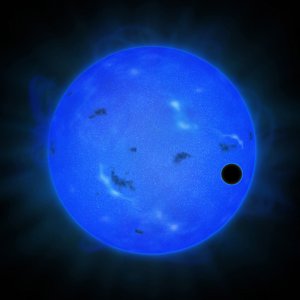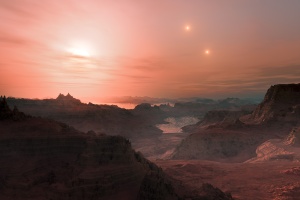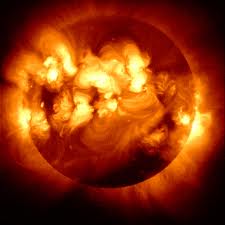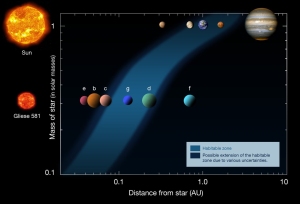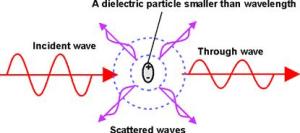The Hitchhiker’s Guide to the Galaxy by Douglas Adams is the first in a series of books based on Adams’s popular 1970s radio series of the same name. First broadcasted on BBC 4 in 1978, by 1979 the first book was already published and had become an international bestseller. Its Monty Python-esque humor has made it a cult classic and it has since been immortalized in plays, comics, and multiple movie adaptations, the most recent being a 2005 blockbuster starring Martin Freeman and Zooey Deschanel. The question is: was it all for good fun, or is there an underlying message conveyed by Adams?

The story follows Arthur Dent, an anxiety-riddled man living in rural England. One day he wakes up to find bulldozers ready to knock down his house to make room for a bypass. As he lies in front of them, warding off the construction workers, his friend Ford Prefect comes and drags him away. As it turns out, not only is Arthur’s house about to be demolished, so is the Earth! Ford is actually an extraterrestrial traveling the stars doing research for The Hitchhiker’s Guide to the Galaxy (a play on The Hitchhiker’s Guide to Europe) who managed to get trapped on the Earth for the past 15 years.
Just before the planet is vaporized, they sneak onto one of the space ships, only to be discovered and thrown out into space a few million light-years later. Luckily, they are picked up by another ship just in time. On the ship they meet Zaphod Beeblebrox, his companion Trillian, and the depressed robot Marvin. Zaphod is actually the President of the Imperial Galactic Government who has just stolen the state of the art ship to search for the lost planet of Magrathea. They eventually find the planet and, after narrowly escaping its millennia-old defense systems, land.
Magrathea used to be a land of infinite wealth and luxury. It catered to the wealthiest of the galaxy by making custom made planets. Now its desert surface is, well, deserted! Arthur eventually encounters a native who tells him of the Earth’s true origin: Millions of years ago, a race of “hyperintelligent pandimensional beings” created a supercomputer to tell them the meaning of life, the universe, and everything. After ten million years, it pronounces the answer to be 42 and proceeds to tell them that it does not make sense because they never knew the question in the first place. It then designs an even greater computer to find out what the question is: the Earth. The beings hired Magratheans to build an “organic computer” where the beings, disguised as mice, experimented on humans. The planet was demolished five minutes before the question was computed, however, and the mice had awoken the Magratheans to build a second Earth. The book ends with them escaping both space cops chasing Zaphod and the mice after Arthur’s brain.
Is it as Simple as it Seems?

Now, as funny of a story as it may be, there are striking similarities between aspects of the book and England in the 1970s. Times were tough. Political tensions were high, energy crises rampant, and a recession was triggered by increased inflation. Trade unions were striking, unemployment was rising, and the people of the United Kingdom were panicking (Sandbrook; “Economic History of the United Kingdom”). If one pays close attention to the details of the book, a clear line can be drawn from Adams’s writing to the time period in which it was written. Uses of the phrase, “Don’t Panic,” the parallel between prime ministers of the time and Beeblebrox, and comparisons of England to Magrathea are all signs that not only is The Hitchhiker’s Guide to the Galaxy an entertaining novel, it is also a political commentary on the economic and political environment of the time in which it was written.
Little Green Pieces of Paper
The first (and perhaps most compelling) example that the novel is a parallel between Adams’s universe and reality is the way in which he describes Earth and its inhabitants. “This planet has – or rather had – a problem, which was this: most of the people living on it were unhappy for pretty much of the time. Many solutions were suggested for this problem, but most of these were largely concerned with the movement of small green pieces of paper, which was odd because on the whole it wasn’t the small green pieces of paper that were unhappy” (Adams 1). This describes the unhappiness of humans with our monetary system and the economy. During the recession, the United Kingdom had to receive a very embarrassing bailout from the International Monetary Fund (IMF) (“Economic History of the United Kingdom”). This general despondency is reflected in the ways in which he portrays earthlings, comparable to the British.
Anxious Arthur and a Panicking Public
Another argument is Adams’s use of the phrase, “Don’t Panic.” It is “[i]nscribed in large friendly letters on the cover” of the fictional guide (3). Arthur frequently refers to it throughout the tale: “’I like the cover,’ he said, ‘”Don’t Panic.” It’s the first helpful or intelligible thing anybody’s said to me all day’” (53). Now, the repetition of the phrase certainly helps Arthur, but would it not also reassure the people of the UK? Panic was an everyday occurrence in the lives of the British. At one point, the government instituted a three-day week to ration energy during the 1973 oil crisis. The year of 1978, when Adams was broadcasting and writing, was also the Winter of Discontent (Sandbrook). By seeing that if Arthur could control his anxiety everything would work out in the end, Adams was sending a message to the public to stay calm and confident that all would be well.
A Useless President

A comparison is also drawn between the prime ministers of the time and President of the Galaxy, Zaphod Beeblebrox. During the 70s, Edward Heath came to power promising a “quiet revolution” of the economy of the country. When the miners striked and the oil crisis began, all hope of this “revolution” disappeared Furthermore, James Callaghan was forced to continually devalue the pound and failed to get Britain to join the European Union multiple times (Sandbrook). Adams turned this into a satire with the position of Galactic President. “The President in particular is very much a figurehead- he wields no real power whatsoever… The qualities he is required to display are not those of leadership but those of finely judged outrage” (39). He describes the President (or, alternatively, the PM) as one who does not actually help the general public at all. He goes on to draw a direct comparison between Zaphod and Heath: “He has already spent two of his ten presidential years in prison for fraud,” referring to Heath’s fraud in his promise of a revolution. He also compares Zaphod and Callaghan: “If there’s anything more important than my ego around, I want it caught and shot now” (97), which tells of Callaghan’s false confidence he could get the country to enter the EU.
Magrathea, Land of the Forgotten 
A final example is the direct link between the UK and Magrathea. Magrathea once was one of the greatest financial powers in the galaxy, much like Britain. It made planets just as England claimed colonies. When the galaxy went into recession, like Europe, it completely shut down all its manufacturing, similar to how all trade unions went on strike. When the characters first arrive, they do not find the legendary planet of wealth, but rather a desert wasteland, much like the economic environment of the United Kingdom. However, Adams does give hope by saying that the planet’s inhabitants will wake up and be successful when the economy of the galaxy improves (which, according to Magrathean calculations (and the shifting political power in late 70s England to Margaret Thatcher) should occur soon) (Adams 152-153; “Economic History of the United Kingdom”).
There are many more examples one could find, but for the purpose of brevity, these are four main examples of the connections between Adams’s fictional universe and the reality of 1970s Great Britain. During a time of economic depression, when for the first time in decades the UK had more immigrants than emigrants (similar to the dolphins leaving Earth in the novel (156)), people needed a little hope. Adams provided this by entertaining the public with his comedy and optimism. His use of the phrase, “Don’t Panic,” as well as promise of an economy picking up (Magrathean calculations) gave people hope while his comparisons between Beeblebrox and the Prime Ministers of the time and witty observations of humans provide satire to simultaneously comment on and distract from the problems of the era. It would be interesting to reread the book in the context of other decades as well, such as 1940s or late 2000s. The greatest part is that this story, despite its messages, transcends the decade to continuously be a source of entertainment to people of all ages and cultures.
Works Cited:
Adams, Douglas. The Hitchhiker’s Guide to the Galaxy. New York: Harmony, 1989. Print.
“Economic History of the United Kingdom (1960-1979: The Sixties and Seventies).”Wikipedia. Wikimedia Foundation, 20 Sept. 2013. Web. 20 Sept. 2013.
Sandbrook, Dominic. “Why Does the 1970s Get Painted as Such a Bad Decade?” The 70s. BBC Two. Apr. 2012. BBC News. BBC, 15 Apr. 2012. Web. 20 Sept. 2013.
Photo Credits as well as an interesting multimedia presentation on my points and a classmates views can be found in a Prezi Presentation by following this link:
http://prezi.com/qzhltqhixr71/?utm_campaign=share&utm_medium=copy


